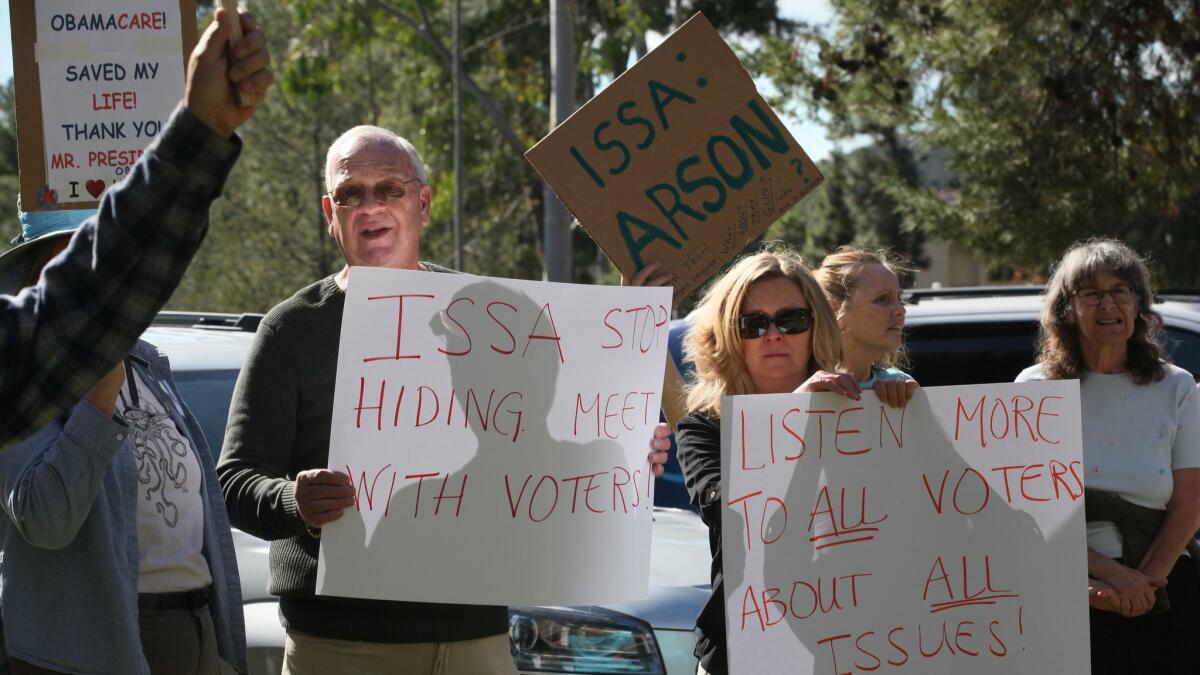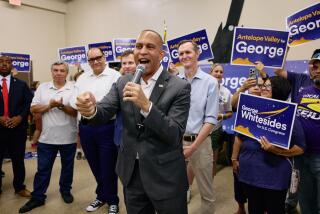Noisy town hall protests show how the left is trying out tea party tactics to fight Trump
There has been no shortage of opportunities for the anti-Trump left to vent their angst since the president took office: Women’s marches, airport protests and impromptu rallies have become a near-daily feature of life in cities across California and the nation.
But people have also begun showing up at less likely venues: strip malls and business parks that house the offices of their members of Congress. Over the weekend, hundreds of people showed up to an overflowing town hall meeting being held by Rep. Tom McClintock (R-Elk Grove) in his Northern California district, which ended when McClintock was escorted out by police while a huge crowd demonstrated outside.
For the record:
3:12 p.m. June 2, 2019An earlier version of this article reported that Rep. Darrell Issa won the November election by 5,300 votes; he won by 1,621 votes. An earlier version also incorrectly stated when protesters at three Southern California representatives’ offices claimed they had been locked out last week; the incidents occurred over the last several weeks, not all within the last week.
“I think the importance was to show Mr. McClintock that we are not going to stand for anyone who’s on board with the Trump agenda,” said Doug Todd, who lives in McClintock’s district and helped organize some of the protesters. “We weren’t just going to smile and nod the whole time.”
Like many of the volunteer organizers, Todd considers his group an affiliate of Indivisible, a group recently created by former congressional staffers trying to deploy the same strategies against President Trump that made the anti-Obama tea party so successful.
Ezra Levin, who co-wrote a protest manual called “Indivisible Guide” with his wife and other former staffers, says the tea party’s focus on congressional representatives and just saying no to policy changes were the main ingredients of its secret sauce.
“They understood the fundamentals of constituent power … because they know that every member of Congress wakes up every morning thinking, ‘Hey, what can I do to get reelected?’ ” Levin said.
Indivisible has become a nonprofit since launching in December, and many of its thousands of registered groups are emerging in places like Orange County and the Central Valley, hardly known as incubators for progressive politics.
The demonstrations organized by these groups haven’t been going entirely smoothly. Protesters at the offices of at least three Southern California Republicans say they have been met with locked doors and staffers who refused to pick up the phone over the past few weeks.
About 200 people gathered outside the office of Rep. Mimi Walters (R-Irvine) last week and couldn’t get inside. Walters spokeswoman Abigail Sigler said that the congresswoman was in Washington at the time and that the office doors were locked because members of the group “have repeatedly harassed the congresswoman’s staff,” including on Twitter.

A similar incident occurred at the office of Rep. Darrell Issa (R-Vista) on Jan. 20, where protesting constituents complained that staff “barricaded” themselves inside and would not accept a letter they had signed. Calvin Moore, a spokesman for Issa, said the office was closed for part of that morning for the inauguration, and that the staff eventually received the letter. At least one other meeting with a small group of protesters was productive, Moore said.
In another incident last Tuesday, police emerged from Rep. Dana Rohrabacher’s Huntington Beach office to confront the protesters, citing concerns about noise and crowding a fire exit.
Ken Grubbs, a Rohrabacher spokesman, said the demonstrators were “disruptive” and made it “impossible to work.” The door is routinely locked so that visitors must identify themselves, Grubbs said. Videos from the most recent incident show self-identified constituents taking turns knocking on the door and then leaving messages on the intercom system. Building management called police, Grubbs said.
Rohrabacher’s is one of seven Republican-held congressional districts in California where Hillary Clinton received more votes than Trump did. Issa, who is regarded as one of the most vulnerable, won reelection by just 1,621 votes. All seven, including Walters, have been named as targets by Democrats for the 2018 election.
“I like to think that the fundamental aspect of their job is to speak to their constituents,” said Mike Lisenbery, who helped organize the demonstration at Rohrabacher’s office. “Regardless of whether I or anybody else voted for him, it’s still our taxes that are paying his salary.”
The 33-year-old Apple store employee said he’s never been this politically involved. In the five weeks since Lisenbery launched his Indivisible OC group on Facebook, nearly 1,300 people have joined.
Levin’s guide instructs would-be activists to follow two tea party tenets: show up on your home turf and play defense by fighting against policies instead of proposing new ones.
Many of the demonstrations have largely done that by focusing on one or two “action items” with each encounter and calling on representatives to oppose specific Trump appointees or policies, such as the refugee ban or the Obamacare repeal.
Outside the Santa Clarita office of Republican Rep. Steve Knight last Thursday, nearly 200 people waited in a line that snaked out of his second-floor suite, summoned in part by local Indivisible organizers. One by one, the protesters handed letters opposing the repeal of the Affordable Care Act to Knight’s staffers as L.A. County sheriff’s deputies looked on. A Knight staffer thanked the protesters for coming and being respectful.
Kathy DeChellis, a 64-year-old retiree and protester, said it was her first demonstration since the 1970s, when she marched through San Francisco’s Golden Gate Park to protest the Vietnam War.
“I decided it was time to get off my retired rear end and do something. We ought to take a lesson from the tea party, organize from the grassroots and get loud,” she said.
Matt Barreto, a UCLA political science professor who coauthored a book about the tea party movement, said this fledgling movement’s success will depend on capturing rank-and-file Americans: At its height, roughly a quarter of Americans identified with the tea party.
“They’re going to need more of a following than the folks who regularly follow Elizabeth Warren and the ACLU on Twitter,” he said. “It is going to need to cross over to the general public, where you have people talking about it at the water cooler and their kids’ soccer games,” said Barreto.
Tea partiers did that in part by creating sustained protests at dozens of town halls, especially during the August 2009 congressional recess, and by building relationships with Republicans like McClintock, who were friendly to their cause.
Some of the protests by Indivisible have been aimed at liberal Democrats like California Sens. Dianne Feinstein and Kamala Harris to encourage them to be more vocal about opposing Trump’s actions. Protesters outside Feinstein’s home urged her to vote against confirming Jeff Sessions, Trump’s pick for attorney general.
Rep. Karen Bass of Los Angeles, a Democrat and former community organizer, sees the outpouring as a positive sign. “The organic movement is great and I am excited about it, and they will probably come to my office, too,” she said.
Bass said she’s seen an uptick in constituents reaching out to her by phone, mail and in person — so many that she’s scheduled two extra town hall meetings in February.
Before his own town hall, tea party favorite McClintock said that he expected a higher-than-usual turnout by progressive constituents and that he was interested to hear what they had to say.
“When you’re in the political minority, you become very alarmed and you engage,” he said. “That was true of the tea party eight years ago, and it’s true of the left now.”
The meeting was reportedly raucous at times, and by Saturday afternoon, McClintock was less enthusiastic.
“I think there was an anarchist element among the organizers,” McClintock said after leaving the meeting. “It’s the first time I’ve ever had a police department have to extract me from a town hall, and I’ve done well over 100 of them in Congress.”
Organizers said demonstrators voiced their opinions loudly, but the protest was nonviolent. “These were families, and senior citizens and women. … It was American and it was supportive of our democracy,” Todd said.
The Roseville Police Department, which decided to escort McClintock out as a precaution, said the protesters were peaceful and no one was arrested.
McClintock refuted the comparison of the protesters to the tea party.
“The tea party engaged people by holding meetings and talking to people and writing letters,” McClintock said. “The way to change the course of the country is not to shout people down, not to riot in the streets.”
But the confrontations at the height of the tea party movement were not all tranquil, either, prompting some Democratic members of Congress to avoid them altogether. In one of many memorable incidents, then-Pennsylvania Sen. Arlen Specter, a Democrat, left a town hall meeting after being booed and shoved by audience members.
Times staff writers Sarah D. Wire and Javier Panzar contributed to this report.
For more on California politics, follow @cmaiduc.
ALSO:
Updates on California politics
People from all around California are heading to the Central Valley to defend Obamacare. Here’s why
More to Read
Get the L.A. Times Politics newsletter
Deeply reported insights into legislation, politics and policy from Sacramento, Washington and beyond. In your inbox three times per week.
You may occasionally receive promotional content from the Los Angeles Times.











